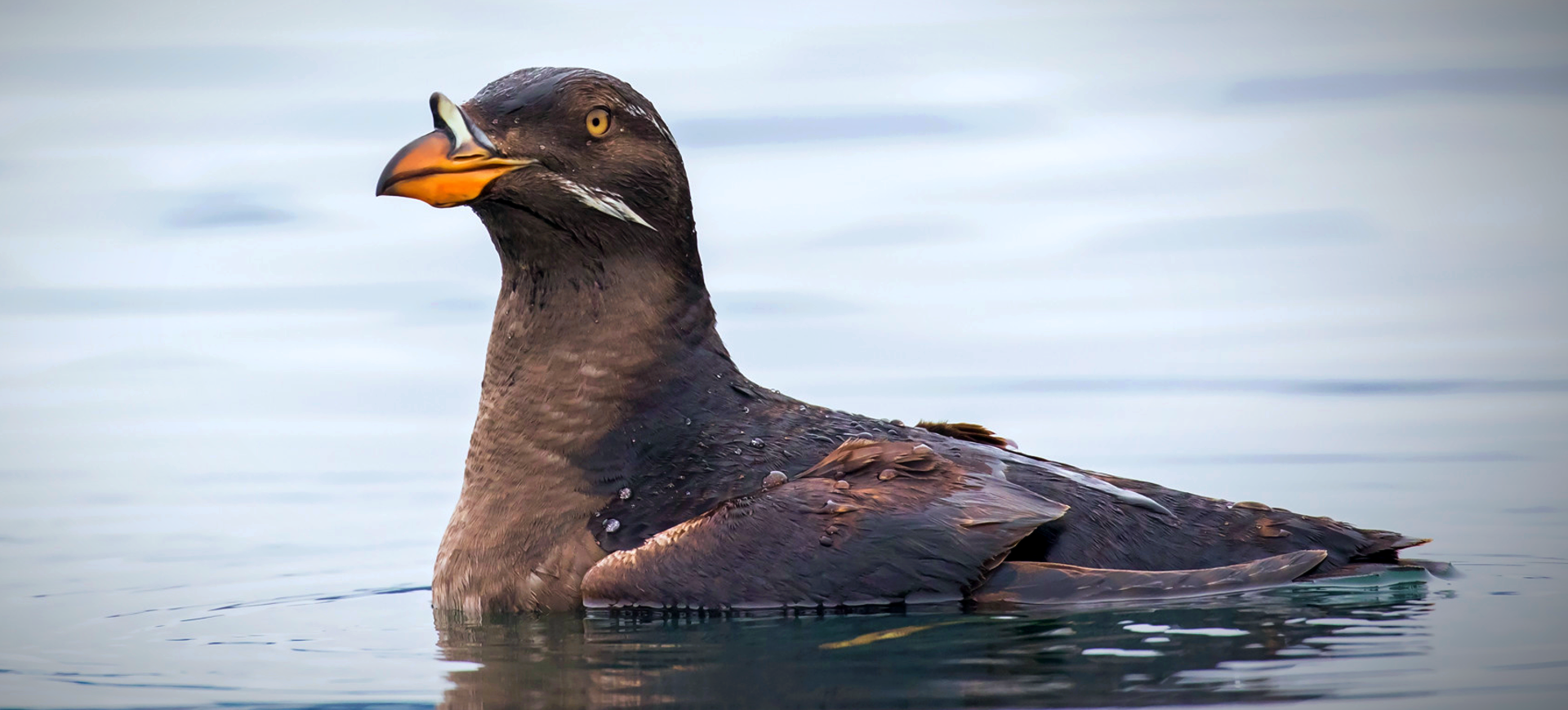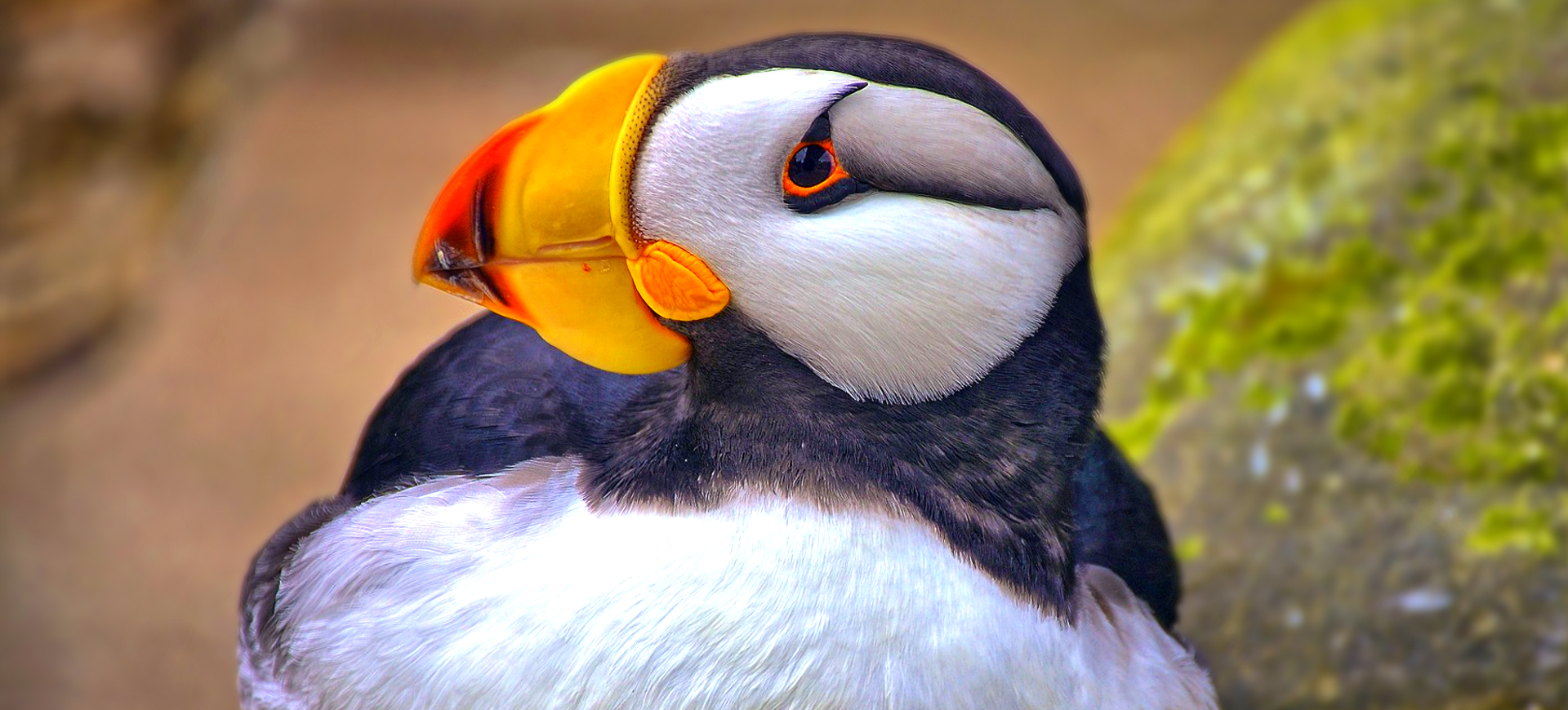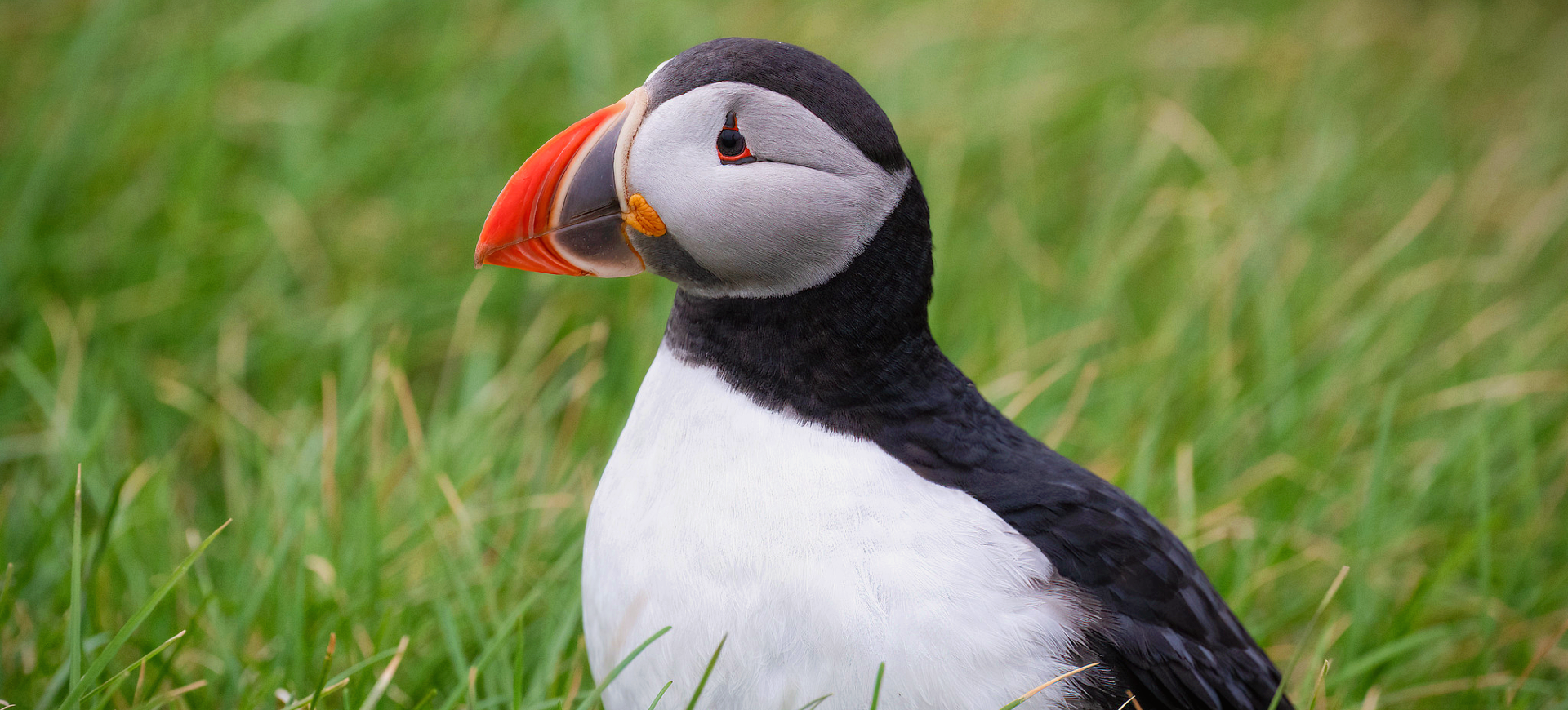Overview
The Tufted Puffin, also known as the Crested Puffin, is a striking seabird known for its distinctive appearance and behaviors. These birds are easily recognizable by their large, bright orange bills and the tufts of yellow feathers that appear on their heads during the breeding season. They inhabit the North Pacific, from the cold waters of the Bering Sea to the coasts of California, nesting on rocky islands and cliffs. Tufted Puffins are excellent swimmers, using their wings to propel themselves underwater to catch fish, their primary food source.
Tufted Puffins spend much of their lives at sea, coming ashore only to breed. They are social birds, forming dense colonies on coastal cliffs where they excavate burrows for their nests. During the breeding season, their beaks and feet turn a vivid orange, adding to their distinctive look. These birds are known for their remarkable diving ability, reaching depths of over 100 feet in search of fish, squid, and crustaceans.
Conservation concerns for the Tufted Puffin include habitat loss, oil spills, and climate change, which impact their food supply and nesting sites. Despite these challenges, Tufted Puffins remain a symbol of the rugged Pacific coast, captivating birdwatchers and nature enthusiasts with their bold colors and charismatic presence. Their adaptability to the harsh marine environment showcases seabirds’ resilience in changing oceanic conditions.
Taxonomy
Kingdom
Phylum
Class
Order
Family
Genus
Species
Type
Physical Description:
Tufted Puffins are medium-sized seabirds, notable for their black body and white facial patches during the breeding season. Their most distinguishing features are the long, golden tufts of feathers that extend from behind the eyes and the large, brightly colored bill. These physical adaptations are not just for show; they are crucial in social interactions and mating displays. The contrast between their dark bodies and bright bills and feet makes them one of the most visually striking seabirds.
Adults can reach about 15 inches long, with a wingspan of approximately 25 inches. Unlike many other bird species, there is little sexual dimorphism between male and female Tufted Puffins, making it challenging to distinguish between the sexes based on appearance alone. Their plumage provides excellent camouflage against predators when viewed from above or below in the water. The compact, robust body of the Tufted Puffin is perfectly adapted for diving, with strong wings used for propulsion underwater.

Lifespan: Wild: ~20 Years || Captivity: ~25 Years

Weight: Male & Female: 1.3-1.6 lbs (600-700 g)

Length: Male & Female: 14-15 inches (35-38 cm)

Height: Male & Female: 13-15 inches (33-38 cm)

Wingspan: Male & Female: 25-29 inches (63-74 cm)

Top Speed: 55 mph (88 km/h)
Characteristic:
Native Habitat:
Tufted Puffins are found across the North Pacific Ocean, from the coasts of Japan and Russia to the shores of California and the Bering Sea. Their preferred habitats are isolated, rocky islands and coastal cliffs where they can nest in burrows or crevices, safe from predators. These locations provide access to the open ocean, where they spend most of their time foraging for food.
Their breeding sites’ rugged, inaccessible nature offers protection against most terrestrial predators, allowing colonies to thrive. During the non-breeding season, Tufted Puffins are highly aquatic, spending their time far from land in the open ocean. This lifestyle demands remarkable adaptations for survival in a vast and challenging marine environment.
Climate Zones:
Biogeographical Realms:
Continents:
Countries:
Diet:
Diet & Feeding Habits:
Tufted Puffins are primarily piscivorous, feeding on a diet of fish, squid, and crustaceans. They are skilled hunters, diving deep into the ocean to catch prey with their large bills. During dives, they use their wings to swim underwater, reaching depths where their prey resides. This foraging behavior is energy-intensive but is essential for feeding their chicks during the breeding season.
The feeding habits of Tufted Puffins are closely tied to the abundance and availability of their prey, which can vary seasonally and regionally. They often forage in groups, using schooling fish and other marine organisms. The success of their foraging efforts is critical for the survival of their chicks, as both parents participate in feeding their offspring. Environmental changes that affect the distribution of their prey can have significant impacts on Tufted Puffin populations.
Mating Behavior:
Mating Description:
Tufted Puffins are monogamous, with pairs forming strong bonds for several breeding seasons. They return annually to the same nesting sites, engaging in elaborate courtship rituals, bill rubbing and vocalizations. These behaviors serve to strengthen pair bonds and secure nesting territories. The breeding season begins in late spring, with both males and females participating in excavating burrows where the female will lay a single egg.
Both parents incubate the egg for about six weeks before hatching. Once the chick, or puffling, emerges, it depends on its parents for food. Tufted Puffins are diligent parents, making multiple foraging trips to feed their growing chick. The chick remains in the burrow for about six weeks until it is ready to fledge and venture into the ocean. The survival of the offspring is heavily dependent on the abundance of food resources and the parents’ ability to evade predators.
Reproduction Season:
Birth Type:
Pregnancy Duration:
Female Name:
Male Name:
Baby Name:
Social Structure Description:
Tufted Puffins are social birds, particularly during the breeding season when they form large colonies on coastal cliffs and islands. These gatherings provide opportunities for social interaction, mating, and communal defense against predators. Outside the breeding season, Tufted Puffins are more solitary, spending their time at sea searching for food. The social dynamics within puffin colonies, including the formation of pair bonds and cooperative behaviors, play a critical role in their reproductive success and survival.
The structure of puffin colonies allows for the efficient use of nesting sites and resources, with birds often returning to the same location year after year. The social nature of Tufted Puffins, combined with their distinctive appearance and behaviors, makes them fascinating subjects for study and conservation.
Groups:
Conservation Status:
Population Trend:
The global population of Tufted Puffins is difficult to quantify due to their wide distribution and inaccessible nesting sites. However, localized studies have shown fluctuations in population sizes, with some colonies experiencing declines. These changes are often attributed to shifts in oceanic conditions, which can affect the availability of their prey. Conservationists are concerned about the impact of climate change, pollution, and fishing practices on Tufted Puffin food sources.
Efforts to conserve Tufted Puffin populations include protecting their breeding habitats from development and pollution. Conservation programs also focus on monitoring populations to understand the impacts of environmental changes and implement strategies for their protection. The resilience of Tufted Puffins to certain environmental challenges offers hope, but ongoing conservation efforts are crucial to ensure their future.
Population Threats:
Tufted Puffins face several threats, including predation by introduced species on nesting islands, oil spills, and entanglement in fishing gear. Climate change poses a significant risk, potentially altering the distribution of their prey and affecting breeding success. Habitat disturbance from human activities, such as the development and recreational use of nesting areas, can also disrupt breeding colonies.
Conservationists are particularly concerned about overfishing small fish and crustaceans, which are crucial to the puffin diet. The cumulative impact of these threats requires targeted conservation strategies, including habitat protection, pollution control, and sustainable fishing practices, to mitigate the impacts on Tufted Puffin populations.
Conservation Efforts:
Conservation efforts for Tufted Puffins include habitat protection, research, and monitoring to track population trends and health. Protected areas and marine sanctuaries safeguard breeding sites and foraging grounds. Environmental organizations and government agencies work together to address threats like oil spills, pollution, and unsustainable fishing practices that impact puffin populations.
Education and awareness campaigns aim to reduce human disturbance at nesting sites and promote ocean conservation. Rehabilitation programs for injured or oiled puffins also contribute to conservation efforts, helping to return healthy birds to the wild. These collaborative efforts are essential for preserving Tufted Puffin populations and the marine ecosystems they inhabit.
Additional Resources:
Fun Facts
- Tufted Puffins can catch and hold multiple fish in their bills at once, thanks to specialized spines on their tongue and the roof of their mouth.
- They can dive more than 100 feet deep in search of prey.
- The tufts of feathers that give them their name appear only during the breeding season.
- Tufted Puffins are among the most aquatic of the puffin species, spending much of their lives far from shore.
- They use their wings to ‘fly’ underwater, propelling themselves with powerful strokes to catch fish.
- The bright colors of their bill and feet fade to duller shades outside of the breeding season.
- Tufted Puffins are known for their robust diving capabilities, able to stay underwater for up to a minute.
- The construction of their nests, deep caves in soil, or crevices in rocks protect their single egg from predators.
- Despite their awkward appearance on land, Tufted Puffins are agile flyers, capable of reaching speeds of 55 mph.
- Their diet varies seasonally, adapting to the availability of different types of fish, squid, and crustaceans.








